




History
Zero Mile Post, is a stone post in Atlanta that marked the terminus of the Western & Atlantic Railway in the 1800’s. It is the symbolic spot where Atlanta began and is located on lower Wall Street, across the railroad tracks from Underground.
Map 1855
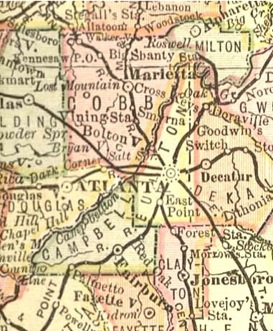

East Point was incorporated Aug. 10, 1887. Was called the “City of Homes and Industry”, and “Georgia’s 7th Largest City.” Was given this name when it was the eastern terminus of the W&A RR.
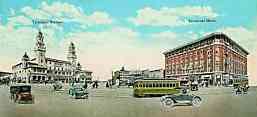



The State of Georgia
One Dollar - 1864

The Bank of the
State of Georgia
50 cents - 1861

Southern Bank of Georgia
One Dollar - 1858

Georgia R.R. Bank Agency
50 cents 1862

The Bank of the State of Georgia
25 cents 1861
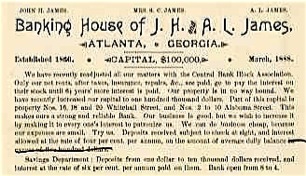
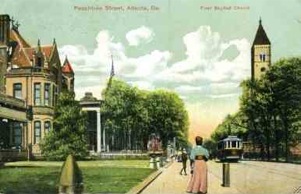
Peachtree Street - First Baptist Church
Atlanta in Ga.
Boosterism ca. 1878
In 1878, the Georgia Department of Agriculture, under Commissioner Thomas P. Janes published
A Manual of Georgia for the use of Immigrants and Capitalists, printed by Ja. P. Harrison & Co. of Atlanta.
Atlanta, the capital town, and seat of government of the State, may be said to be the railroad center of the South. It has an altitude of 1,087 feet above the sea, and is located on the water shed which divides the waters of the Atlantic from those of the Gulf of Mexico, in latitude 33°45`19.8", longitude 84°23`29.7". Population, in 1877, 35,956, (now considerably increased) about one-third black; has 8 hotels, 44 churches, 1 medical college with 100 students, 9 public free schools with 4,100 enrolled scholars--2,500 white, 1,600 black--56 teachers; private schools 5, pupils 350; Atlanta University, (colored) 125 students; Theological Seminary, (colored) 50 students; 1 daily paper, 8 weekly, 2 monthly, 2 periodicals, (monthly) 15 printing offices, 3 binderies, 9 banks, 50 dry goods stores, 9 shoe stores, 490 grocery stores, 36 drug stores, 27 fruit stores, 60 licensed physicians, 71 licensed lawyers, 8 dentists, 40 places of miscellaneous business.
Five Points, Atlanta, constitutes Atlanta’s hub, from which principal thoroughfares radiate in five directions to all parts of the metropolitan area. This wedge shaped area is at the intersection of Peachtree, Decatur, Marietta Streets and Edgewood Ave. This intersection is called, “The Wall Street of the South,” as it is the state’s financial center. Originally the town Well was at the spot, settled before 1814. Originally called Gravel Hill, it was then named after its first settler, William Fleming.
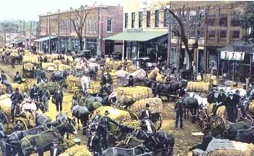
Cotton Season Marietta 1904
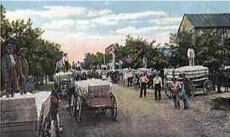 Cotton Ginning Day
Cotton Ginning Day Atlanta 1973
Atlanta 1973 Atlanta 1964
Atlanta 1964“A people without the knowledge of their history, origin and culture, is like a tree without roots.”
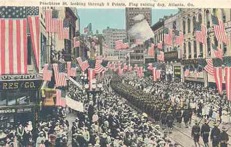
Peachtree Street on Flag Raising Day
Atlanta Georgia 1919
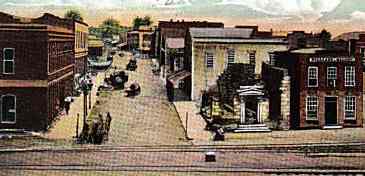
Peachtree Street 1864
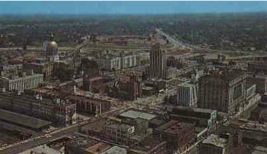
Atlanta 1964

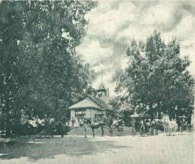
Piedmont Driving Club 1908

Piedmont Driving Club Entrance 1913
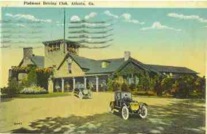
Piedmont Driving Club 1930
Atlanta’s history, characteristic of it’s adolescence, is a chronology of energetic personalities and rapid changes. The first mention of the region is found in Revolutionary War records dated Aug. 1, 1782,
which state that a secret emissary had been delegated to report on rumors of friction between the Cherokee and Creek Indians at the Standing Peachtree. Named accordingly to legend, for a fruit bearing tree that grew on a nearby Indian mound, the Standing Peachtree was a Creek settlement on the
southern bank of the Chattahoochee River, approximately seven miles from the present site of Atlanta. The Creek are said to have acquired the region south of the river from the Cherokee in a series of
decisive ball games, with the land rights at stake.
Because of the disturbances between the Creek and Cherokee, Lieutenant George R. Gilmer, later Governor of Georgia, was commissioned in 1813 to erect a fort at Standing Peachtree; he and twenty two recruits constituted the first white settlement in the Atlanta area. After his departure, the Standing Peachtree grew into an important trading post and gateway to northern Cherokee lands.
The founding of Atlanta was due to the enterprise of pioneer railroad men. In 1836 representatives of
the existing railroads through the mountains of north Georgia to connect the proposed termini of their lines at the Chattahoochee River with the Tennessee River. The charter of the Monroe Railroad was amended on Dec. 10, 1836, to provide for the extension of that line from Forsyth to the Chattahoochee River, and eleven days later the Western & Atlantic Railroad was chartered to be built at state expense.
A year later a legislative act provided for the extension of the Western & Atlantic to a point not
exceeding eight miles from the southeastern bank of the Chattahoochee River. The promoters of the Georgia Railroad were permitted by the same assembly to extend their line from Madison to the
terminus of the Western & Atlantic.
The proposed junction of the railroads, referred to as Terminus, soon became a trading center for the surrounding country, with two stores, a saw-mill, and a railroad office. In 1843 the settlement was incorporated as the town of Marthasville in honor of Martha Lumpkin, daughter of the Governor. When the Georgia Railroad was completed in 1845, Marthasville was considered an inappropriate name for so progressive a community, and the town was given the name Atlanta as a feminine version of Atlantic, taken from the Western & Atlantic Railroad. The following year, when Atlanta, the town’s commercial importance increased so rapidly that on Dec. 29, 1847, Atlanta was reincorporated as a city. The corporate limits of the new city were within a circle, the center of which was the Western & Atlantic zero milepost near the southwestern corner of Wall Street and Central Avenue.
The new county of Fulton was created from DeKalb County on December 20,1853, and Atlanta was made it’s seat. In 1854, the population was approximately 6,000.

